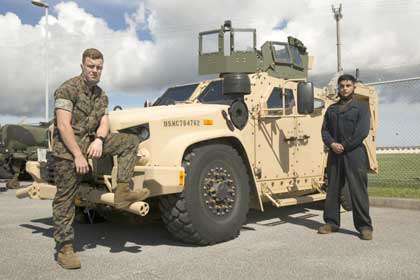
OKINAWA, JAPAN — (left to right) U.S. Marine Lance Cpl. Evan M. Simonds, a motor transport operator with Truck Co., Headquarters Bn., 3rd Marine Division, and Lance Cpl. Eduardo Tenaperez, motor transport mechanic, stand with the Joint Light Tactical Vehicle (JLTV) here, Sep. 18. The vehicle is one of two models currently being fielded and maintained with the unit. Eventually, the JLTV will replace the Humvee and revolutionize the mobility and reliability of motor transportation throughout the Marine Corps. U.S. Marine Corps photo by Gunnery Sgt. Jacob H. Harrer.
The JLTV, revolutionizing motor transportation in the Marine Corps
OKINAWA, JAPAN – The Joint Light Tactical Vehicle (JLTV) is integrated into training on Okinawa, and it is already changing the way the Marines envision motor transportation.
The JLTV will cut down thousands of hours of annual maintenance and allow Marines to drive to remote locations with minimal mechanical support, said Staff Sgt. Robert O. Sempell, Shop Chief, Truck Company, Headquarters Battalion, 3rd Marine Division.
Sempell added that the JLTV will work well with the Commandant’s vision for the structure of the force. According to the 38th Commandant’s Planning Guidance, Marines must remain dispersed and undetected to make it difficult for enemy forces to strike at troops on the ground in the Indo-Pacific region.
“III MEF will become our main focus-of-effort, designed to provide [commanders] with a fight-tonight, stand in force capability to persist inside an adversary’s weapon systems threat range,” reads the guidance. “We disperse to reduce our signature to avoid detection. In a precision strike regime, sensing first and shooting first are a tremendous advantage.”
The JLTV is an ideal vehicle for the Marines in Okinawa. Normally, motorized troops require a sizeable support element to maintain vehicles in the field. The JLTV has several advanced features that reduce the maintenance requirements, including the number of mechanics, said Sempell.
The JLTV achieves this through a diagnostics touch screen called the Driver Side Display Unit (DSDU). The screen works similarly to civilian vehicles. The driver can view tire pressure, engine temperature, fluids and various other readings in real time. This allows operators and mechanics to quickly identify issues and correct them before they escalate.
In addition to quick and accurate diagnostics, the system allows Marines to adjust suspension height and prime the fuel, two tasks that would normally require hours of maintenance. With the touch of a button, Marines can lower the vehicle for easy loading onto ships. Conversely, the JLTV can be raised to allow drivers to ford small bodies of water. Lastly, an internal system can pressurize the fuel in five minutes—a task that could take up to several hours to manually prime on the Humvee.
These advanced features enable Marines to easily keep their vehicles running for longer periods of time. According to Sempell, the JLTV is simple enough for many drivers to maintain and operate with proper training. This would allow Marines to drive in teams of four with limited support over long periods of time—a perfect fit for the “low signature,” hard-to-detect forces envisioned by Gen. David H. Berger, 38th Commandant of the Marine Corps.
In addition to advanced diagnostics, the JLTV is designed to withstand blasts and has an advanced cooling system that forces a high volume of air into the engine and transmission. The technology is a revolutionary upgrade from the up-armored Humvees that carried Marines into battle during Operation Iraqi Freedom.
For Marines who may be hesitant to adopt the new technology, Sempell encourages his fellow staff noncommissioned officers to attend training and learn the system to keep up with the junior Marines.
“Just like when smartphones came out, we wanted to avoid them because we didn’t know how to use them,” explained Sempell. “Once we saw what we could do with them, we all wanted a smartphone.”
By integrating new technology like the JLTV, Marines will continue to adapt to the current environment and be ready to fight now.
Military News | Navy News | USMC Joint Light Tactical Vehicle


